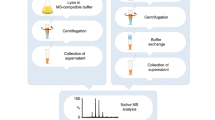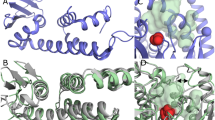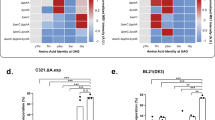Abstract
Recombinant proteins produced in prokaryotes or eukaryotes show certain types of heterogeneity due to post-translational modifications. Some preparations of a soluble interferon γ receptor, produced inEscherichia coli, appeared as a double band with slightly different mobilities in non-reducing sodium dodecylsulfate and native polyacrylamide gels. Ion spray mass spectrometry showed that the two forms had a mass difference of one to three multiples of 97 ± 2 D. Gas chromatography-mass spectrometry analysis revealed the presence of phosphoric acid in the hydrolysate and in the intact protein. The more slowly migrating protein species had trapped molecules of phosphoric acid during the protein extraction. Most of the trapped phosphoric acid was loosely associated with the protein. One to three molecules were tightly, but non-covalently linked per receptor molecule. Phosphoric acid entrapment did not affect biological activity and most likely did not affect protein conformation. The species carrying phosphoric acid showed higher solubility. Trapping of phosphoric acid by proteins may be a general phenomenon and the results reported here thus useful in the characterization of other recombinant proteins.
This is a preview of subscription content, access via your institution
Access options
Subscribe to this journal
Receive 12 print issues and online access
$209.00 per year
only $17.42 per issue
Buy this article
- Purchase on Springer Link
- Instant access to full article PDF
Prices may be subject to local taxes which are calculated during checkout
Similar content being viewed by others
References
Bialy, H. 1987. Recombinant proteins: Virtual authenticity. Bio/Technology 5: 883–890.
van Leen, R.W., Bakhuis, J.G., van Beckhoven, R.F.W.C., Burger, H., Dorssers, L.C.J., Hommes, R.W.J., Lemson, P.J., Noordam, B., Persoon, N.L.M. and Wagemaker, G. 1991. Production of human interleukin-3 using industrial microorganisms. Bio/Technology 9: 47–52.
Müllner, S., Karbe-Thönges, B. and Tripier, D. 1993. Charge heterogeneity of insulin fusion proteins expressed in Escherichia coli is not due to proteolytic degradation. Anal. Biochem. 210: 366–373.
Yan, S.C.B., Grinnell, B.W. and Wold, F. 1989. Post-translational modifications of proteins: some problems to solve. Trends Biol. Sci. 14: 264–268.
Geisow, M.J. 1991. Characterizing recombinant proteins. Bio/Technology 9: 921–924.
Fountoulakis, M., Juranville, J.-F., Stüber, D., Weibel, E.K. and Garotta, G. 1990. Purification and biochemical characterization of a soluble human interferon γ receptor expressed in Escherichia coli. J. Biol. Chem. 265: 13268–13275.
Fountoulakis, M., Lahm, H.-W., Maris, A., Friedlein, A., Manneberg, M., Stüber, D. and Garotta, G. 1991. A 25-kD stretch of the extracellular domain of the human g interferon receptor is required for full ligand binding capacity. J. Biol. Chem. 266: 14970–14977.
Fountoulakis, M. and Gentz, R. 1992. Effect of glycosylation on properties of soluble interferon gamma receptors produced in prokaryotic and eukaryotic expression systems. Bio/Technology 10: 1143–1147.
Fountoulakis, M. 1993. Unfolding intermediates of the extracellular domain of the interferon γ receptor. J. Biol. Chem. 267: 7095–7100.
Stüber, D., Friedlein, A., Fountoulakis, M., Lahm, H.-W. and Garotta, G. 1993. Alignment of disulfide bonds of the extracellular domain of the interferon γ receptor and investigation of their role in biological activity. Biochemistry. 32: 2423–2430.
Chowdhury, S.K., Katta, V., Beavis, R.C. and Chait, B.T., 1990. Origin and removal of adducts (molecular mass=98 u) attached to peptide and protein ions in electrospray ionization mass spectra. J. Am. Soc. Mass Spectrom. 1: 382–388.
Gentz, R., Hayes, A., Grau, N., Fountoulakis, M., Ozmen, L., Lahm, H.-W. and Garotta, G. 1992. Analysis of soluble human and mouse interferon γ receptors expressed in eukaryotic cells. Eur. J. Biochem. 210: 545–554.
Fountoulakis, M., Zulauf, M., Lustig, A. and Garotta, G. 1992. Stoichiometry of interaction between interferon γ and its receptor. Eur. J. Biochem. 208: 781–787.
Ozmen, L., Fountoulakis, M. and Garotta, G. 1992. A novel solid-phase test to study the binding of IFNγ to its receptor. J. Immunol. Methods 147: 261–270.
Greenwood, F.C., Hunter, W.M. and Glover, J.S. 1963. The preparation of 131l-labeled human growth hormone of high specific radioactivity. Biochem. J. 89: 114–123.
Hochuli, E., Bannwarth, W., Döbeli, H., Gentz, R. and Stüber, D. 1988. Genetic approach to facilitate purification of recombinant proteins with a novel metal chelate adsorbent. Bio/Technology 6: 1321–1325.
Garotta, G., Ozmen, L., Fountoulakis, M., Dembic, Z., van Loon, A.P.G.M. and Stüber, D. 1990. Human interferon γ receptor. Mapping of epitopes recognized by neutralizing antibodies using native and recombinant receptor proteins. J. Biol. Chem. 265: 6908–6915.
Fountoulakis, M., Takacs-di Lorenzo, E., Juranville, J.-F. and Manneberg, M. 1993. Purification of interferon γ-interferon γ receptor complexes by preparative electrophoresis on native gels. Anal. Biochem. 208: 270–276.
Fountoulakis, M., Kania, M., Ozmen, L., Lötscher, H.-R., Garotta, G. and van Loon, A.P.G.M. 1989. Structure and membrane topology of the high-affinity receptor for human IFNγ: Requirements for binding IFNγ. One single 90-Kilodalton IFNγ receptor can lead to multiple cross-linked products and isolated proteins. J. Immunol. 143: 3266–3276.
Fountoulakis, M., Juranville, J.-F. and Manneberg, M. 1992. Comparison of the Coomassie brilliant blue, bicinchoninic acid and Lowry quantitation assays, using non-glycosylated and grycosylated proteins. J. Biochem. Biophys. Methods 24: 265–274.
Author information
Authors and Affiliations
Rights and permissions
About this article
Cite this article
Fountoulakis, M., Vilbois, F., Oesterhelt, G. et al. Phosphoric Acid Entrapment Leads to Apparent Protein Heterogeneity. Nat Biotechnol 13, 383–388 (1995). https://doi.org/10.1038/nbt0495-383
Received:
Accepted:
Issue Date:
DOI: https://doi.org/10.1038/nbt0495-383



